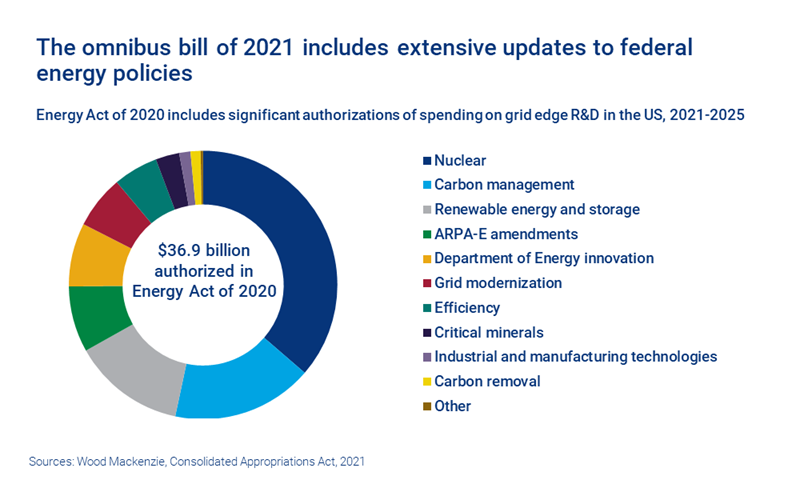From federal spending to Texas blackouts: key themes shaping the US grid edge
Highlights from our grid edge quarterly briefing
1 minute read
The growth of distributed energy resources on the grid edge continues to influence many sectors of the energy industry. In recent weeks we’ve seen this play out in everything from the way the federal government is investing in the electricity grid of the future, to the response to blackouts in Texas.
Each quarter, our Grid Edge team provides a comprehensive briefing, including updates and analysis of the key themes and developments in the grid edge ecosystem. Fill out the form to access a complimentary extract from the latest briefing or read on for three key themes to watch.
1. For the first time in over 10 years, the federal government is investing billions into the grid edge – and planning more
At the end of 2020, the omnibus spending bill, also known as the Consolidated Appropriations Act, 2021, was signed into law, comprising US$900 billion of Covid-relief and a US$1.4 trillion government funding package. The Act includes US$2.3 billion for investments in grid modernization and an additional US$1.9 billion for energy efficiency upgrades and research.
The Biden administration has also issued the Executive Order (EO) titled 'Tackling the Climate Crisis at Home and Abroad'. Among the priorities listed, the administration intends to leverage the federal government’s footprint and buying power to push power sector decarbonization, electrification and activation of grid flexibility.
The EO singles out procurement of carbon pollution-free electricity and clean, zero-emission vehicles by federal agencies. The federal government currently owns 645,000 vehicles, with less than 4,000 fully electric vehicles (EVs). By contrast, we currently track just over one million cumulative EVs purchased in the US through the end of 2020. If executed, this procurement could dramatically impact EV sales in the US going forward.
While the EO does not specifically mention the role of federal buildings and the president’s broad authority over them, funding for energy efficiency in the spending bill could be critical in achieving broader sustainability and grid flexibility goals. In total, the federal government owns and leases more than three billion square feet of floor space across all states and is the largest real estate owner in the US.
2. Heating electrification in the US will decimate demand for heating oil and transform summer-peaking electric grids into winter-peaking grids
Dozens of jurisdictions across the country are implementing building codes and regulations restricting natural gas heating. So, we’re closely tracking the impact on natural gas heating demand, oil demand and seasonal peaks in electricity demand through 2050.
In the near term we see immediate impacts in the way new construction developers are considering gas hookups for residential and commercial customers. We will also see the beginning of historically summer peaking grids become winter peaking, as heating electrification increases demand through the winter months.
As we look to mid-century, residential and commercial demand for heating electrification will cut demand for gas for heating. While a relatively small impact for natural gas heating demand, heating electrification will decimate oil heating demand.
3. Texas has been a consistent market for microgrids – and that was before February’s blackouts swept the state
Texas was one of the most resilient microgrid markets in 2020. It was one of the only states to see year-on-year growth in microgrid deployment, despite project delays from the coronavirus response. That was prior to the blackouts that caused more than four million customers to lose power in Texas.
These microgrids were put to the test in February. We tracked 269 projects with over 700 MW of generation. Microgrids kept the lights on and operations running for many commercial customers. In addition, they supported hospitals, military bases, senior living homes, critical water infrastructure and universities. So microgrids both worked to provide power for customers who would otherwise be without it and supported the grid – often by islanding voluntarily to decrease demand on the central electric system.
Hurricanes and tropical storms already regularly cause power outages across Texas’ Gulf Coast. The power outages experienced during February’s blackout reinforce the importance of companies, government agencies and institutions planning for electrical resilience using distributed energy resources and microgrids.
Our Grid Edge team explores these topics and more in our Grid Edge Quarterly Executive Briefing. Fill in the form at the top of the page for a complimentary extract, which includes:
- Investments by energy sector from the omnibus spending bill
- The impacts of electrical heating on natural gas heating demand
- Historic microgrid demand by geography.






